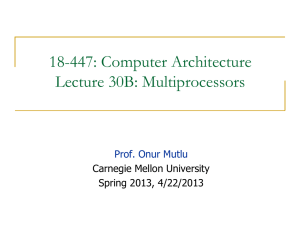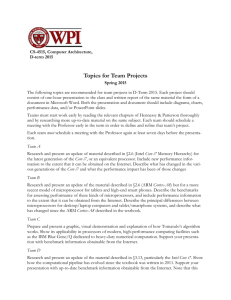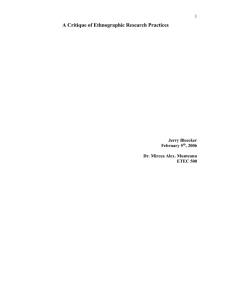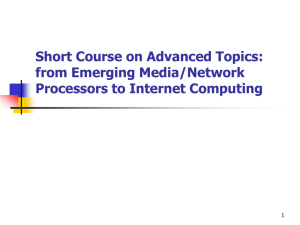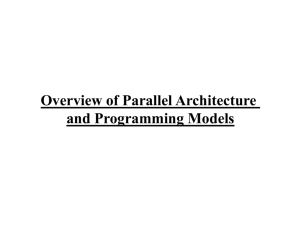A Parallel Computing-a Paradigm to achieve High performance. Prof
advertisement
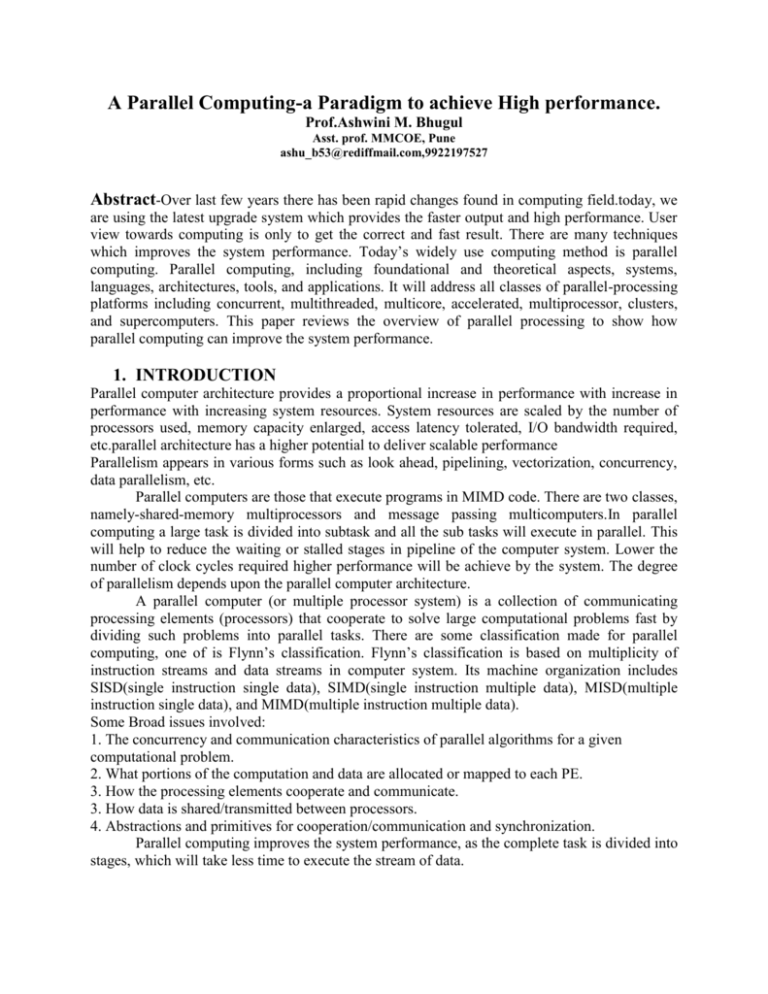
A Parallel Computing-a Paradigm to achieve High performance.
Prof.Ashwini M. Bhugul
Asst. prof. MMCOE, Pune
ashu_b53@rediffmail.com,9922197527
Abstract-Over last few years there has been rapid changes found in computing field.today, we
are using the latest upgrade system which provides the faster output and high performance. User
view towards computing is only to get the correct and fast result. There are many techniques
which improves the system performance. Today’s widely use computing method is parallel
computing. Parallel computing, including foundational and theoretical aspects, systems,
languages, architectures, tools, and applications. It will address all classes of parallel-processing
platforms including concurrent, multithreaded, multicore, accelerated, multiprocessor, clusters,
and supercomputers. This paper reviews the overview of parallel processing to show how
parallel computing can improve the system performance.
1. INTRODUCTION
Parallel computer architecture provides a proportional increase in performance with increase in
performance with increasing system resources. System resources are scaled by the number of
processors used, memory capacity enlarged, access latency tolerated, I/O bandwidth required,
etc.parallel architecture has a higher potential to deliver scalable performance
Parallelism appears in various forms such as look ahead, pipelining, vectorization, concurrency,
data parallelism, etc.
Parallel computers are those that execute programs in MIMD code. There are two classes,
namely-shared-memory multiprocessors and message passing multicomputers.In parallel
computing a large task is divided into subtask and all the sub tasks will execute in parallel. This
will help to reduce the waiting or stalled stages in pipeline of the computer system. Lower the
number of clock cycles required higher performance will be achieve by the system. The degree
of parallelism depends upon the parallel computer architecture.
A parallel computer (or multiple processor system) is a collection of communicating
processing elements (processors) that cooperate to solve large computational problems fast by
dividing such problems into parallel tasks. There are some classification made for parallel
computing, one of is Flynn’s classification. Flynn’s classification is based on multiplicity of
instruction streams and data streams in computer system. Its machine organization includes
SISD(single instruction single data), SIMD(single instruction multiple data), MISD(multiple
instruction single data), and MIMD(multiple instruction multiple data).
Some Broad issues involved:
1. The concurrency and communication characteristics of parallel algorithms for a given
computational problem.
2. What portions of the computation and data are allocated or mapped to each PE.
3. How the processing elements cooperate and communicate.
3. How data is shared/transmitted between processors.
4. Abstractions and primitives for cooperation/communication and synchronization.
Parallel computing improves the system performance, as the complete task is divided into
stages, which will take less time to execute the stream of data.
1.1General overview of parallel processing system:
PU1
MEM1
CU
PU2
PUn
n
MEM2
2
MEMn
2
CU-control unit
PU-processing unit
MEM-memory
Figure 1.1: SIMD architecture showing parallel computing
Figure 1.1 shows general SIMD architecture. Both data and instructions are fetched by memory
module. Instructions are decoded by the control unit, which sends to processor units for
execution. Each instruction stream is generated by an independent control unit. Multiple data
stream originates from shared memory module. This improves the system speedup and
performance.
1.2 Need of Parallel Computing
Whenever there is need to work on large amount of data, system need a fast performance,
more computing cycles/memory needed, there will be overload on machine when it performs a
whole task, parallel computing make this task efficient by dividing a task into stages that will
reduce the computing clock cycles and memory too. Some of the applications of parallel
computing are: Scientific/Engineering computing: CFD, Biology, Chemistry, Physics, Generalpurpose computing: Video, Graphics, CAD, Databases, Transaction Processing, Gaming, etc.
Number of transistors on chip growing rapidly. Clock rates expected to continue to go up
but only slowly. Actual performance returns diminishing due to deeper pipelines. Increased
transistor density allows integrating multiple processor cores per creating Chip-Multiprocessors
(CMPs) even for mainstream computing applications that is also one of application of parallel
processing
The increased utilization of commodity of-the-shelf (COTS) components in high
performance parallel computing systems instead of costly custom components used in traditional
supercomputers leading to much lower parallel system cost. Today’s microprocessors offer highperformance and have multiprocessor support with parallel processing.
2. Different granularities of parallelism
In parallel computing units of work can be execute concurrently if sufficient recourses exists.
There are two granularities:
2.1 Thread level parallelism
2.2Instruction level parallelism
2.1Thread level parallelism (TLP)
A thread is separate process having its own instructions and data. Thread may be a separate
process or single program executing in parallel. In parallel computing, the thread offers different
instructions and data so that the processor can switch to another thread and can continue the
instructions, this will include the thing that, processor will continuously execute instructions
without stalls, this will take less time to execute instructions.TLP is a software that enables a
program often a high end programs such as web application, etc.
There are two approaches to TLP:
1. Fine-grained multithreading
2. Coarse-grained multithreading
Fine grained multithreading switches threads on each instruction, that will execute multiple
instructions simultaneously, CPU must be able to switch threads every clock cycles. The
advantage of using this technique is that it can hide both short and long stalls.
Coarse-grained multithreading switches threads only when current thread is likely to stall for
some time.it is more natural for any given thread and consume less time to switch threads. It is
also easier to implement switching process.
2.2 Instruction Level Parallelism
Instruction-level Parallelism CILP) is a family of processor and compiler design techniques that
speed up execution by causing individual machine operations to execute in parallel. Pipelining
can overlap the execution of instructions when they are independent on each other, this potential
overlap among instructions is called as Instruction level Parallelism. Processing instructions in
parallel requires some tasks:
1. Checking independencies between instructions, if two instructions are independent on
each other, they can be group together to execute in parallel.
2. Assigning instructions to the functional units on hardware.
3. Determining when instructions are initiated. This include the technique called score
boarding, it allows instructions to execute out of order when there is sufficient resource
available.
ILP architectures can be classified as follows.
Sequential architectures: architectures for which the program is not expected to convey
any explicit information regarding parallelism. Superscalar processors are representative
of ILP processor implementations for sequential architectures.
Dependence architectures: This architecture provides information of those programs in
which instructions which are dependent on each other. Dataflow processors are one of the
examples of this architecture.
Independence architectures: architectures for which the program provides information
as to which operations are independent of one another. Very Long Instruction Word
(VLIW) processors are examples of the class of independence architectures.
3. Some Parallel Programming Techniques
Sometimes in large scale industries, there is a multiprocessor system, which requires
number of instructions to be executed simultaneously, as the system consists of number of
processor connected together there may happens some memory conflicts while performing tasks
parallel. Processor needs to communicate with each or want to share some data with each other;
hence there are some parallel programming techniques, three of them are explained below:
3.1. Message passing parallel programming
In massage passing programming programs view their programs as a collection of
cooperating processes with private variables. This style is suitable for message passing parallel
computers. This technique needs only two primitives that is send and receive, that will send or
receive instructions from one processor to another. Figure given below showing MessagePassing example of Intel Paragon.
Figure 31: Sandia’s Intel Paragon XP/S-based Supercomputer
There are most widely used Message Passing Programming tools are:
1. Message Passing Interface (MPI):
It provides a standard for writing concurrent message-passing programs.MPI offers rich
set of functions for doing point to point communicaton.it will divide a task into stages and that
separate tasks can communicate with each other.MPI implementations include parallel libraries
used by existing programming languages (C, C++).
2. Parallel Virtual Machine (PVM):
PVM is portable message passing programming system, designed to form separate host
machines to from “virtual machine”. Virtual machine is collection of processors that may work
simultaneously or at different time. It enables a collection of heterogeneous computers to use as a
coherent and flexible concurrent computational resource. PVM support software executes on
each machine in a user configurable pool, and provides computational environment of concurrent
applications. User programs written for example in C, FORTRAN or Java are provided access to
PVM through the use of calls to PVM library routines.
3.2. Shared Memory Programming
In shared memory programming, programmers view their programs as a collection of
cooperating processes that will access a common pool of shared variables. In such computers,
processors may not have private program or data memory. a common data or program is stored
in shared memory that will use by all processors. The main program creates separate processes
and assigns a tasks to every processor with a common shared memory, each processor computes
independently and after all, result of each processor stored in common memory. Two statements
are use for this purpose: 1. Fork 2. Join
Example: Process X;
Process Y;
fork y;
join y;
end y;
Process X when it encounters fork y invokes another process y, after invoking y, it continues
doing its work. Process y starts executing concurrently in another processor. When X reaches
join y statement has to wait till y finish its work. In shared memory programming when multiple
processors are in use and sharing a common memory so care has to be taken that no two
dependent instructions should execute simultaneously. For shared memory programming three
models of multiprocessors are:
1. The Uniform Memory Access (UMA) Model:
In this model all physical memory is shared by all processors. All processors have equal access
to all memory addresses.
2. Distributed memory or Non-uniform Memory Access (NUMA) Model:
In this model, Shared memory is physically distributed locally among processors. Access latency
to remote memory is higher.
3. The Cache-Only Memory Architecture (COMA) Model:
In this model, A special case of a NUMA machine where all distributed main memory is
converted to caches. No memory hierarchy at each processor.
3.3 Data parallel Programming
In Data Parallel Programming many programs can apply same operation to each element
of composite data.sometimes, looping statements performed repetitive tasks, using data
parallelism this repetition carried out automatically by having multiprocessors working
concurrently. Logically, single thread of control, performs sequential or parallel steps
conceptually, a processor is associated with each data element. Example machines, Thinking
Machines CM-1, Maspar MP-1 and MP-2, etc.Data parallel programming makes programs easy
to read and write. Same program will be executed over different data sets simultaneously on
multiple processors. a popular data parallel programming language is high performance Fortran
(HPF). figure 3.3 given below shows example of data parallel systems.
Control Processor
PE
PE
PE
PE
PE
PE
PE
PE
PE
Figure 3.3: Data parallel system (All PE’s are synchronized)
Array of many simple processors each with little memory. Processors don’t sequence through
instructions.
Attached to a control processor that issues instructions Specialized and general communication,
global synchronization
4.Conclusion
At the end of this review paper, we may observe some current some current trends. High
performance computers are increasingly in demand, Parallel computing architecture is today’s
widley used architecture which provides speed and high performance. It is used in many
scientific, engineering, medical, military and research areas to achieve high system performance.
5.References
1. Rafiqul Zaman Khan, Md Firoj A Comparative Study on Parallel Programming Tools in
Parallel Distributed Computing System: MPI and PVM, Department of Computer Science,
Aligarh Muslim University, Aligarh-202002,(U.P), India.
2.B. Ramakrishna Rau, Joseph A. Fisher, Instruction-Level Parallel Processing: History,
Overview and Perspective, Computer Systems Laboratory,HPL-92-132,October, 1992.
3. M. D. Smith, M. Horowitz and M. Lam. Efficient superscalar performance through boosting.
Proc. Fifth International Conference on Architectural Support for Programming& Laneua&es
and Operating Systems (Boston, Massachussetts, October 1992), 248-259.
4.R. Chaiken, B. Jenkins, P.-_A. Larson,B. Ramsey, D. Shakib, S. Weaver, and J. Zhou. SCOPE:
Easy and e_cient parallel processing of massive data sets. International Conference of Very
Large Data Bases (VLDB), August 2008.
5.D. DeWitt and J. Gray. Parallel database systems: The future of high performance database
processing. Communications of the ACM, 36(6), 1992.
6. R. Pike, S. Dorward, R. Griesemer, and S. Quinlan. Interpreting the data: Parallel analysis
with Sawzall. Scienti_c Programming,13(4):277{298, 2005.
7. F. Rabhi and S. Gorlatch. Patterns and Skeletons for Parallel and Distributed Computing.
Springer, 2003.
8. Y. Yu, M. Isard, D. Fetterly, M. Budiu,U. Erlingsson, P. K. Gunda, and J. Currey.DryadLINQ:
A system for general-purpose distributed data-parallel computing using a high-level language. In
Proceedings of the 8th Symposium on Operating Systems Design and Implementation (OSDI),
December 8-10 2008.
9. R. Z. Khan, A. Q. Ansari and Kalim Qureshi―Performance Prediction for Parallel Scientific
Application‖, Malaysian Journal of Computer Science,Vol. 17 No. 1, June 2004, pp 65-73.
10. Kai Hwang, Faye A. Briggs, "Computer Architecture and Parallel Processing" McGraw-Hill
international Edition
11. Kai Hwang, "Advanced Computer Architecture", Tata McGraw-Hill
12. V.Rajaraman, L Sivaram Murthy, "Parallel Computers", PHI.




